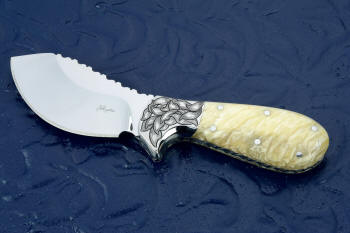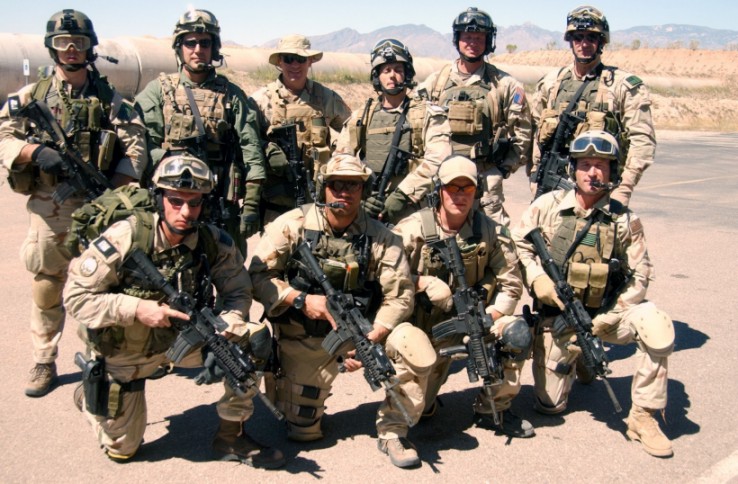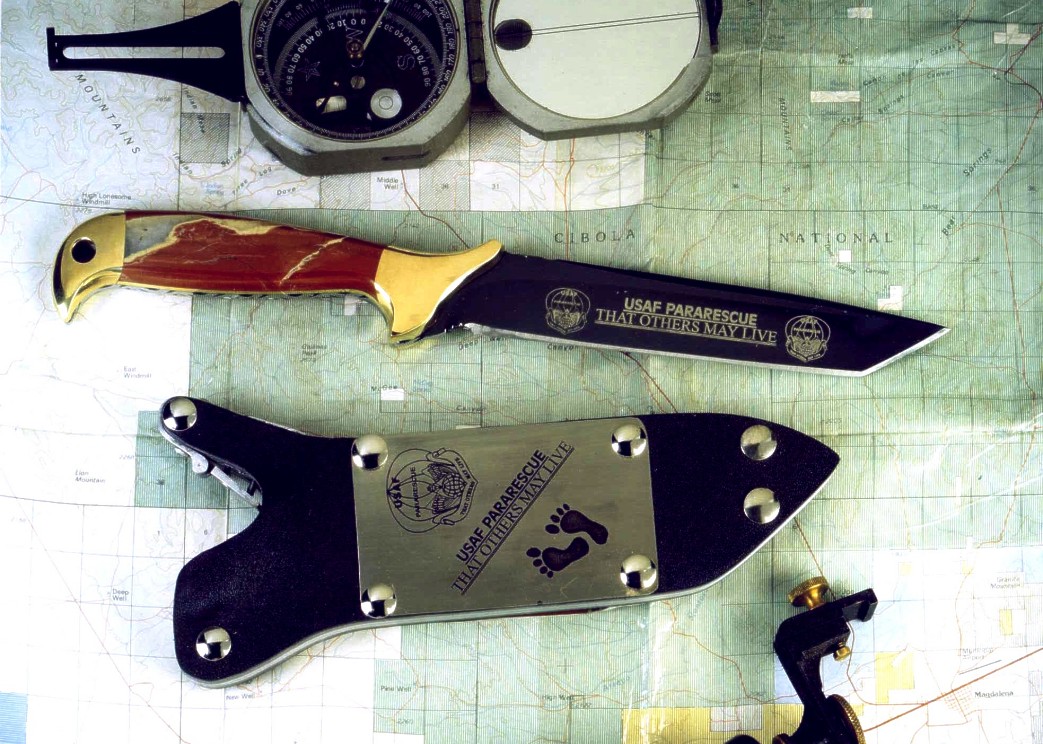The PJLT: Pararescue's Most Popular CSAR Knife
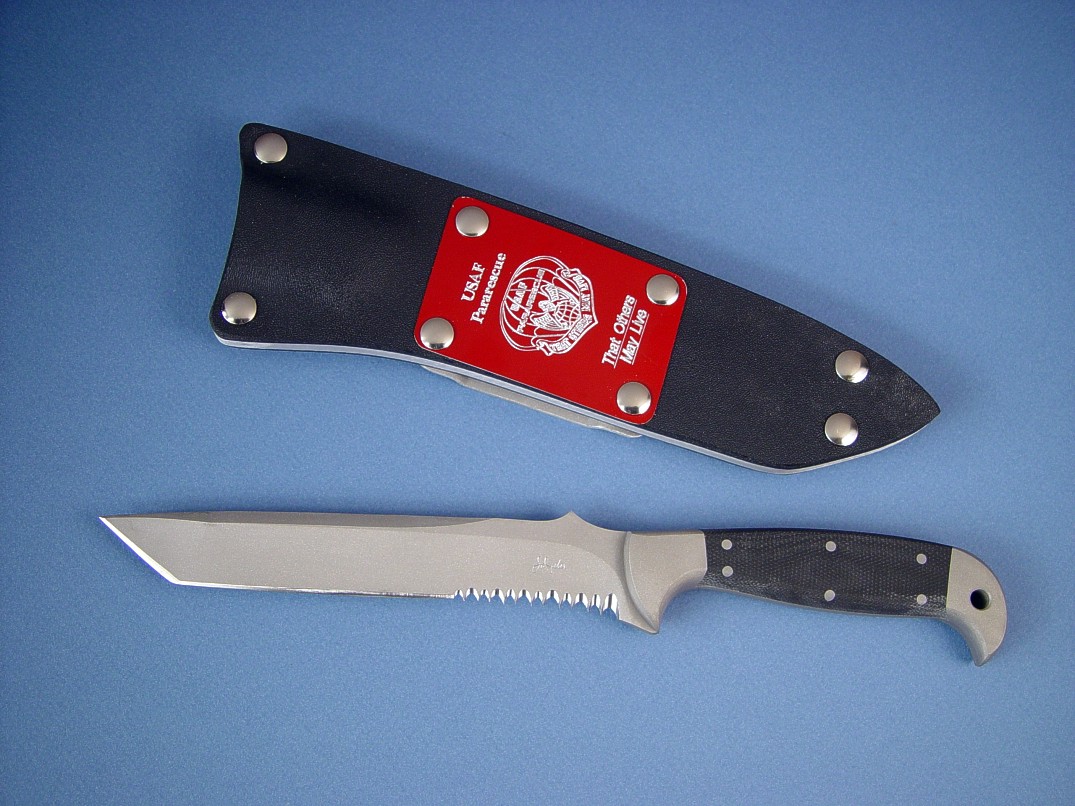 More
More about this PJLT
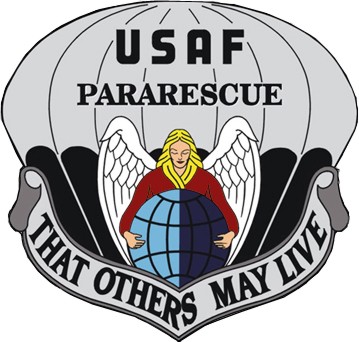
On this page, you will read topics about my most popular tactical combat search and rescue knife, the PJLT (Pararescue
Jumper LighT). There are captioned thumbnail photo boxes, and if there is an associated page to that photo with more
information, photographs, and details, they will be linked in blue.
Thanks for being here and thanks for supporting our
military, rescue, and law enforcement professionals who make it possible
for us to love the life we live in the United States of America!
Jay,
This is Jared Lay; my family has bought several knives from you. I bought my brother, Jeremiah Lay, a PJLT
Shank knife for him when he graduated the fire academy. Well, long story short, my brother uses the knife
all the time and just had it with him in the Philippines, after the destruction. He went into some areas
for rescue that were the first rescue people in. Just wanted you to know we love the knives you have
made and that they are doing great work across the world.
--Jared Lay
Over a 25 years ago, a small group of men dressed in battle dress
uniform rang the doorbell of my knife shop and studio in Magdalena, New
Mexico. They told me they were conducting tactical training exercises twenty
miles north of the village, in a remote part of the South Central New Mexico
badlands. They were PJs.
PJ is the acronym for Pararescue Jumper, the short
name version members of the United States Air Force Pararescue. This
highly trained soldier-paramedic-rescue service consists of
some of the finest men in our military, indeed some of the finest
men in our country. They expend incredible amounts of
training, endurance, education, practice, and trials to
become the guys who go behind enemy lines to rescue other
men. USAF Pararescue is, simply, our best and finest
military combat rescue service.
PJs are also asked to perform rescues in civilian
emergency crisis situations. When civilian rescues
are more than civilians can handle, and are where civilian rescue
services can't go, USAF Pararescue will be there, answering
the call. They do this so that others may live.
When this elite group of men asked if I could make
some knives, some very special knives, I was deeply
honored to give them my best. They worked with me to design
their dream knives that they would use and carry in the
field. It started with a small group
of knives: the Paraeagle, the Creature, the
SERE Kid, and
the large PJ as the initial knives designed by active duty
Pararescuemen for their use in combat and rescue. Of these four, the
PJ was
created to be a large and imposing tanto-bladed weapon and
tool, with substantial size and meat for heavy use. Though
the large-sized PJ was and still is a very popular
knife design with military, rescue service, professionals,
and collectors, I took it upon myself to design a smaller,
lighter version, that was easier to carry, yet had some of
the same great features, components, and geometry of the larger
knife. From these earlier designs, I created the PJ LighT,
or PJLT.
As soon as I finished the first PJLT, I knew I had a hit.
This was a substantial knife, toughly designed with just the
right geometry and balance to be extremely useful, reliable,
and a worthwhile adjunct to the rescue service skill, while
retaining the characteristics to be a viable and formidable
weapon when needed. With the addition of some useful
features like my vampire rip-teeth serrations and top length
spine swages, the PJLT has proven itself in the field of
combat, service, and rescue across the wide range of
tactical and rescue service. While being Pararescue's most
popular knife, it has also become a favorite of SWAT team
members, Emergency Response Units, Law Enforcement, and even
Hazardous Materials professionals.
With the history, design, and reputation of the PJLT, it
is not surprising that it is my most popular knife overall.
I make more PJLTs than any other knife in my pattern inventory of
over 400 patterns.
The PJLT is clearly a fine knife, originally designed for
CSAR and utility use, a knife that has become a necessity
for many well-equipped professionals, valued by collectors,
and depended on by knife users and enthusiasts.
Page Topics
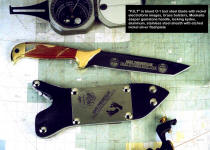
PJLT Commemorative
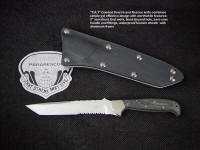
USAF Pararescue Knife
"My sheath held my knife in place at all times... On one mission when
rappelling into a hot HLZ with a 70 lbs pack I went upside down and got
drug when the Helo decided to spilt, my knife was there.
Jay, I know of no other knife that you made that have seen so much action. From the
first ever Jump mission conducted at the PJ School to the 2 OEF
deployments 23 Combat missions in all; not to forget multiple peace
time missions. When my life depends on my knife why carry anything but
the very best. Thanks for building the best for the best."
--SZ (Super), USAF Pararescue
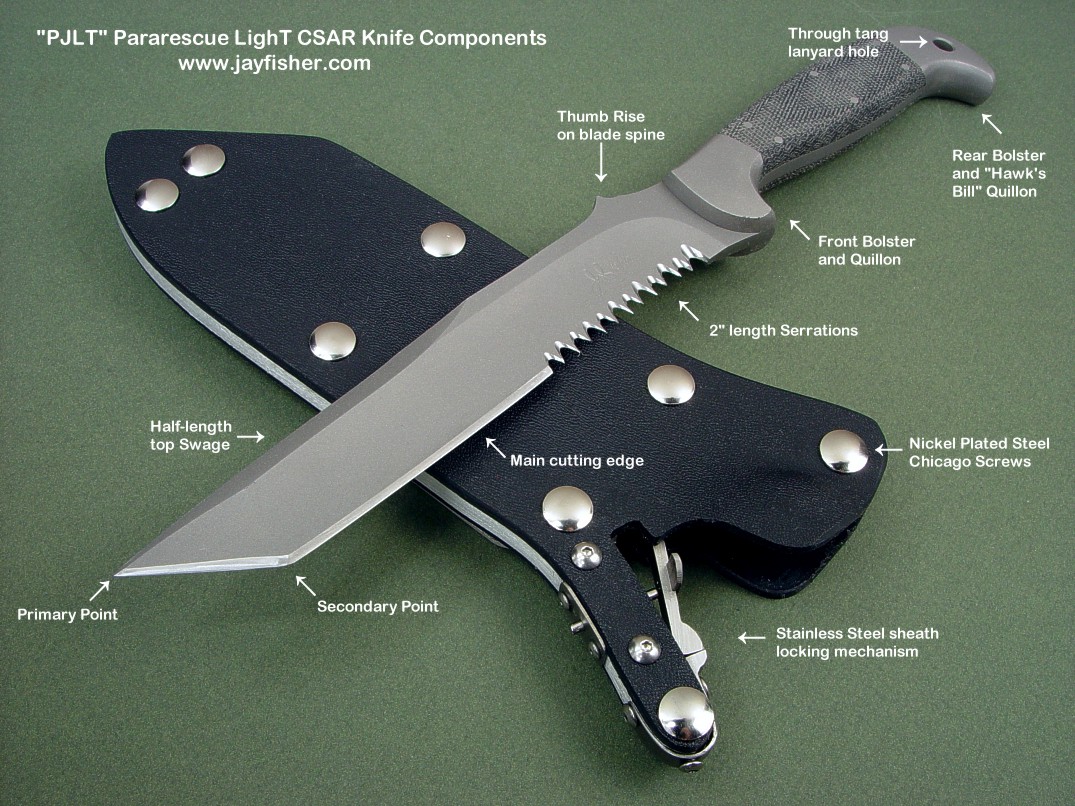 More
More about this PJLT
- The Blade: The PJLT can best be described as a tanto-bladed
tactical knife. It is medium-sized in the range of knives I make,
but don't think that it is small or not up to the task. The blade lengths are typically six inches measured
from the point to the front bolster face, which offers significant knife reach.
- The Primary and Secondary Point: The tanto point has two
distinct angles of cutting edge, which creates two
distinct point profiles. The primary point is the typical
tip of the point, and the secondary point is located where the two
cutting edges converge. Because it is designed with wide
angles, the primary point has a wide geometry with
significant metal to support the point when thrusting or
piercing. With the secondary point, the user can bear down
on the spine of the knife with the heel of his hand and
apply tremendous pressure that he would not be able to apply
in any other blade shape when cutting through tough textiles
and materials. Because there are two distinctive points, the
primary point can be preserved for sharpness and piercing
while the secondary is used for more demanding applications.
Due to the geometry at the union of the two linear edges at
the secondary point, this point is physically stronger than the
primary point.
- The Cutting Edges: The edges of the
PJLT are straight. Without complex curves, the knife is more
easily held at the correct and uniform angles against the
stone to apply and maintain accurate angles to produce a
superior cutting edge. These days, I start most PJLTs with a
single bevel cutting edge, but the knife owner can easily
adapt a double bevel cutting edge as recommended by
Juranitch's course in
Razor Edge Sharpening for a durable,
dependable cutting edge.
- The Hollow Grinds: This knife blade is
deeply hollow ground and the grinds are well-matched and
accurate. They are thick enough to be durable and thin
enough for a low sharpening angle and increased blade
longevity. That means that the geometry of the grind creates
a thin and significantly sharp cutting edge because the
knife blade is not thick like a flat grind or a convex
grind. Because the hollow grind is thin into the midline of
the knife blade, resharpening is easier, and the longevity
of the knife blade is great even after repeated sharpenings.
This is a knife that can last for generations. The hollow
grinds are terminated with sweeping curves so mechanical
blade-to-handle stresses are distributed across a wide area
of the ricasso. The primary point grind is also hollow
ground, at a slightly thicker geometry so that the point is
physically strong.
- Serrations: Though some PJLTs are made
without serrations, most of my clients request the
typical two inches of my vampire rip teeth serrations at the
ricasso. These serrations have developed from my military
client's original requests of having rip teeth that work,
even if broken off. Too many manufacturers make serrations
that are decorative only, and they wanted the most
aggressive serrations possible. My vampire serrations are so
named because they have alternating radius cuts into the
hardened edge of the knife blade, creating a varying
geometry and point set that can improve the ripping ability.
The serrations are cut at a very low angle, creating
extremely aggressive points at the confluence of the grinds.
These points dig deep into textiles, hardwood, bone, and a
wide variety of materials that make them extremely useful.
They are diamond ground for a crisp, clean geometry and are
not washed-over or rounded.
- Thumb Rise: The PJLT has a modest thumb
rise incorporated into the spine of the knife blade. This
gives purchase for the thumb when held in a forward saber
grip, stabilizing the grip while helping to prevent the hand
from sliding forward. The thumb rise can also offer control
with the thumb over the front of the rise, for more
controlled cutting tasks. The thumb rise also offers an area
for the lock tang set if the knife is equipped with a
locking sheath.
- Full Tang: The PJLT is a full tang
knife, one solid piece of steel from the tip of the point to
the butt of the handle. This is the strongest arrangement
for an extreme use knife and offers tremendous strength at
the ricasso, where the blade and handle meet. There simply
is no stronger blade to handle geometry than the full tang.
- Blade Materials: Most of the PJLTs I
make are in 440C (SAE 51440C) high chromium martensitic
stainless tool steel, the same steel used to make corrosion
resistant ball bearings, valve seats, and tools. This steel
is usually chosen for the PJLT because it is durable and
wear-resistant, yet is highly corrosion resistant for marine
and wet exposures. It can be field sharpened, though it is
harder to sharpen than most other tool steels, and is
reliable with a long and proven reputation. Some of the
clients request the slightly tougher ATS-34, or the more
wear resistant CPMS30V (which usually can not be field
sharpened). I can make the knife in any steel my clients
request.
- The Fittings: The fittings of this knife are the
bolsters, handle pins, and lanyard tubes.
- The front bolster is designed to bolster the
blade-to-handle junction, strengthening the entire
knife while offering a wide area for the forefinger
quillon to help lock the hand into the handle and
prevent the hand from sliding forward onto the
blade. It also widens the area at the thumb for
applying pressure to bear down on the knife's
cutting edge. The front bolster also aids in bedding
and physically locking the handle scales to the
blade, as the bolsters are accurately dovetailed.
- The rear bolster strengthens
the butt of the knife handle. The rear bolster has a
substantial hawk's bill quillon shape to offer an
area to pull when extracting from the knife sheath
and to lock the hand into the handle for grip
security. The rear bolster is substantial enough for
light impact, and typically has a lanyard hole that
extends completely through both rear bolsters and
through the tang of the knife handle. Many clients
provide their own personalized lanyards depending on
their service duty, use, or requirements. The
lanyard holes are chamfered to minimize rubbing and
wear of the lanyards. Like the front bolster, the
rear bolster is dovetailed to help bed the handle
scales and strengthen the entire handle.
- Lanyard Tubes: When a PJLT is
requested that does not have a rear bolster (for
lighter duty and a decreased weight), a lanyard tube
is used to prevent splitting or wear of the handle
materials. It is of the same metal as the bolsters
and other fittings, and is chamfered and dressed to
minimize rubbing and wear of the lanyard.
- Pins: The typical arrangement
of the PJLT calls for pins securing the handle
scales. The pins are the same material as the
bolsters, and are through the entire tang and both
handle scales for mechanical security. Multiple pins
are used instead of few for greater strength,
durability, and longevity. The pins are set in zero
clearance holes for stability and prevention of
infiltration of contaminants.
- Materials: Though the PJLT is a
custom knife and any material can be requested for
the bolsters, pins, and handle fittings, mostly I
use 304 austenitic stainless steel. This is a high
nickel, high chromium stainless steel and the same
material used on most stainless steel bolts and
fasteners. While many other makers use 416 stainless
because it's easier to machine, it is not as
corrosion resistant, hard, or tough as 304. 304
stainless steel is a zero care stainless. I can also
use naval brass, nickel silver, or other metals per
client's request.
- The Handle: The handle of the PJLT
is a full tang handle; it's construction is typically
two handle scales attached to the sides of the knife
blade tang, secured by the dovetails on the bolsters,
the through-tang pins, and a high quality polyepoxide
thermoset adhesive. The handle scales are solid, secure,
and permanently bedded to the handle and sealed against
moisture and contaminant infiltration. The tang of the
PJLT is fully tapered properly milled for weight balance
so that the knife is not handle heavy, even when using
higher-mass handle materials like gemstone. The handle
is contoured and nicely shaped for comfort, and blended
with the bolsters for uniformity. The handle is not too
bulky, and in the standard configuration can accommodate
most hands, even gloved.
- Micarta Phenolic: Most of my
PJLTs have micarta phenolic handle scales. Micarta
is the trade name for a fine phenolic thermoset plastic, which
is waterproof, lightweight, and extremely tough and
durable. The phenolic can be impregnated paper,
linen, or canvas for increased strength and texture.
It is available in a variety of colors and textures.
Mostly, I use heavy canvas reinforced micarta
phenolic in black, and when bead blasted it offers a
distinctive gray pattern and texture that feels
secure to grip.
- G-10: This is a fiberglass-epoxide
thermoset industrially manufactured material
that is harder than micarta and offers a more
distinctive color pattern. It has most of the same
properties as micarta.
- Exotic Hardwoods: There are
numerous options of hardwood that are durable enough
and have high duty reliability to use on the PJLT,
for those who prefer the warmth and character of
wood. I only use the harder, heavier types for this
tactical knife.
- Gemstone: I frequently make
PJLTs with gemstone handles, some are even in
combat. The gemstones I use are hard, tough, and
extremely durable, requiring no care. Many of my
investment grade PJLTs are handled in gemstone.
- Horn, Bone, and Ivory: Because
these are somewhat porous materials and of limited
durability, I do not make the PJLT with this type of
handle.
- The Finish: How a PJLT is finished
depends on the blade steel, the handle and fitting
material, and the handle material. Most of my PJLTs are
bead blasted for a flat, non-glare finish if they are to
be use in tactical exposures, but some clients request
mirror finish for a lower care factor, higher corrosion
resistance, and greater long-term value.
Page Topics
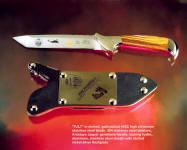
PJLT Commemorative
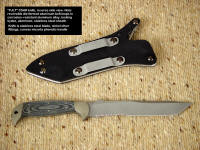
PJLT, Reverse view
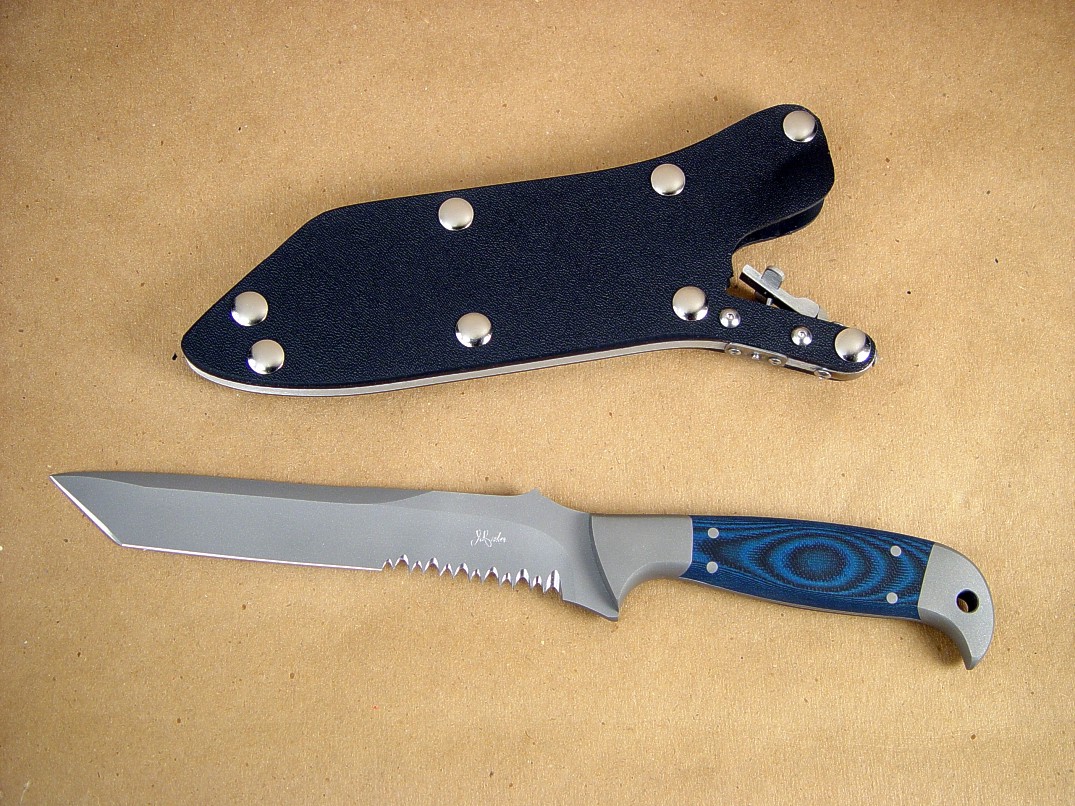 More
More about this PJLT
The PJLT was originally designed as a light Pararescue CSAR (Combat
Search and Rescue) knife with tactical combat applications. It has found
favor across many fields, from civilian rescue organizations,
firefighters, SERE (Survival, Evasion, Resistance, and Escape)
specialists, law enforcement and SWAT (Special Weapons and Tactics)
teams, combat infantrymen and even professional smokejumpers. I've made this knife for
a wide range of specialists and knife enthusiasts, and even made several
in collector's grade, materials, embellishment, and finish.
The main directive of the PJLT is and always will be
United States Air Force Pararescue, and the knife has even
found favor with the instructors at the PJ school at
Kirtland Air Force Base in Albuquerque, New Mexico. I'm honored to
make these knives.
Some of the best knife stories I've heard come from the
owners of this knife. One was used to rescue a Navy SEAL
from a wrecked APC, one was used to pry the skin off a
damaged HELO. One was used to save a trapped PJ's life by
severing a nasty cargo net from a tossing tanker in the
middle of the ocean. One was used in a critical rescue
effort of a collapsed building, and several others have been
used to defend a life in CQC (Close Quarters Combat). Others
are at the ready, strapped to a PJ, during jumps in combat
and over the ocean.
I can't go where these knives do, but I'm thrilled to
know they are there!
Page Topics

PJLT with Tension Sheath
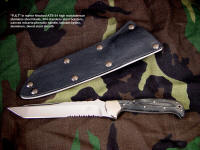
PJLT in Linen Micarta

PJLT CSAR Knife
Thanks Jay.
We all really appreciated that you took time
out of your day, as busy as you are, to let us come by and
check everything out. It was very impressive to see all the
work, skill and care that goes into the knives you produce.
I also wanted to express thanks for being so supportive
toward what were trying to do, and more so, the military in
general. We all thought that was really nice. I'm really
excited about this knife, just the plastic cut out today was
neat, I cant wait to see the finished product.
Once again thanks,
--N.F., USAF Pararescue
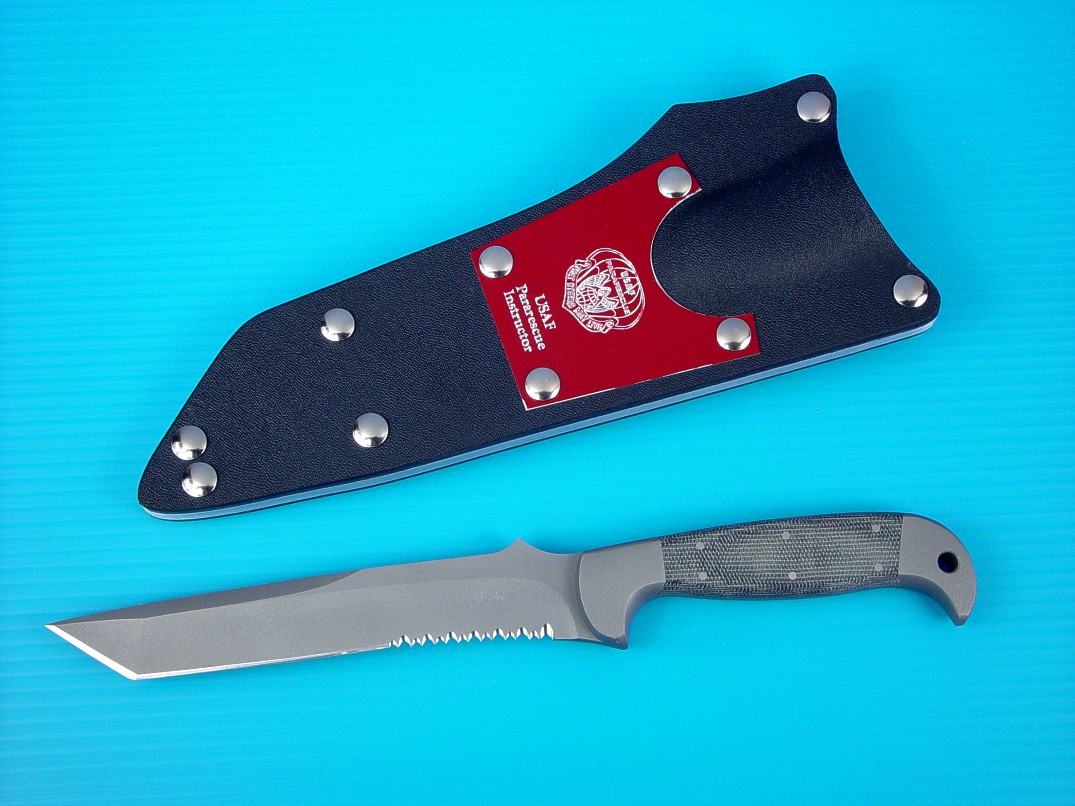 More
More about this PJLT
Jay,
Just wanted to drop you a quick line. I picked up the knife from fed ex last night
and everything is there. Your work is superb! This thing is very light and fast in
the hand I cant wait to get it into action. Some people think I am crazy for spending
so much on a blade, but in the end knives are worth every penny! Especially if you
carry one as your back up weapon and your primary cutting tool into an environment
where it must work. Thanks again for your superb work again! Great job!
Vic, US Navy
Since the PJLT is custom and handmade, it can be made in any size,
with any materials, finish, embellishment, and personalization that the
client desires. On this page, you'll see many different types of PJLT,
and I'll add more as they are made. Some useful options and accessories
should be considered for optimization of a custom knife.
- Blade features: I usually include a
top swage in the blade spine, though some knives are not
made with it. The swage decreases point penetration
cross-section, in other words, it makes a more pointed,
sharper point. Since the swage is not deeply ground
(like blade grinds or cutting edges) it does not
significantly thin the spine or weaken it. This makes
the PJLT blade able to pierce better, useful for CQB and
CQC use and defensive tactics. Some clients want the
maximum blade point strength available or they never
intend to use the knife in combat, so they omit the top
swage. The swage can be any length, and mine for this
knife are usually about half of the blade length or
half-length.
- Serration variations: I have several
variations of serrations that can be applied to the PJLT. See
all of my current serration types, geometries, and styles, plus
lots of information, details, and instructions on sharpening and
serration applications and limitations on my
Serrations page.
- Filework can be simple, complex, or
omitted altogether. Filework can increase the texture on
the blade spine and in the handle tang, and increase
grip potential as it sets the knife apart as an
original, handmade work. More about filework on my
embellishment page.
- Sheaths for the PJLT are usually
kydex, are also leather:
- Kydex tension sheaths are made
of double thickness (.125") thermoforming kydex (methylacrilate
and polyvinylchloride) formed over a welt-frame of
5052H32 corrosion-resistant, high-strength aluminum
alloy. They are adhesively secured with waterproof
bonding agents, lined to protect the cutting edge
with specialized epoxy based materials, and
mechanically bonded with either nickel plated steel,
blued steel, or stainless steel Chicago Screws. Most
of them have reversible die-formed 5052H32
corrosion-resistant, high-strength aluminum alloy
belt loops that are additionally sealed with
acrylic, and some have removable flashplates made of
machine-engraved lacquered aluminum or brass.
- Kydex Locking sheaths are
made of double thickness (.125") thermoforming kydex
(methylacrilate and polyvinylchloride) formed over a
welt-frame of 5052H32 corrosion-resistant,
high-strength aluminum alloy. They are adhesively
secured with waterproof bonding agents, lined to
protect the cutting edge with specialized epoxy
based materials, and mechanically bonded with either
nickel plated steel, blued steel, or stainless steel
Chicago Screws. They have all stainless steel
locking components and machine screws, for the
ultimate in corrosion resistance, suitable for
temporary submersion. Most of them have reversible
die-formed 5052H32 corrosion-resistant,
high-strength aluminum alloy belt loops that are
additionally sealed with acrylic, and some have
removable flashplates made of machine-engraved
lacquered aluminum or brass. More on a
special
page.
- Sheath accessories include
Sheath Belt Loop Extensions, the Ultimate Sheath
Belt Loop Extension, and Sternum Harnesses. More
information on those on a
special
page.
- Leather sheaths for the PJLT
are made of 9-10 oz. leather shoulder, hand-stitched
with polyester sinew, lacquered and sealed. These
may have tooling, inlays, engraving, or other
artistic components suited to the individual knife.
More on my Sheaths page.
Page Topics
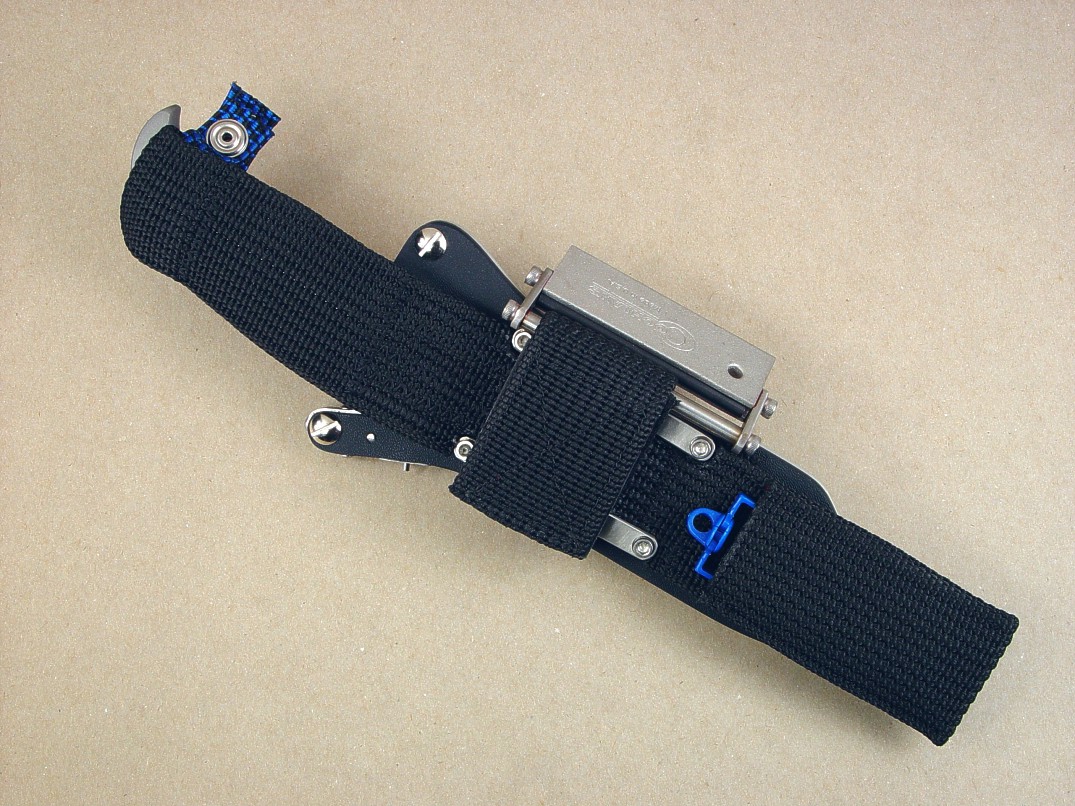 More
More about this PJLT and Accessory
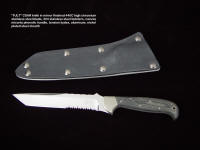
PJLT CSAR Knife
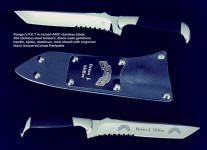
Ranger PJLT
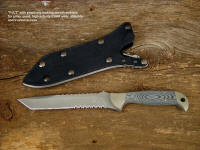
PJLT Knife
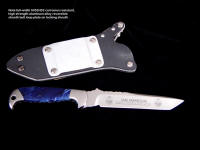
PJLT Commemorative
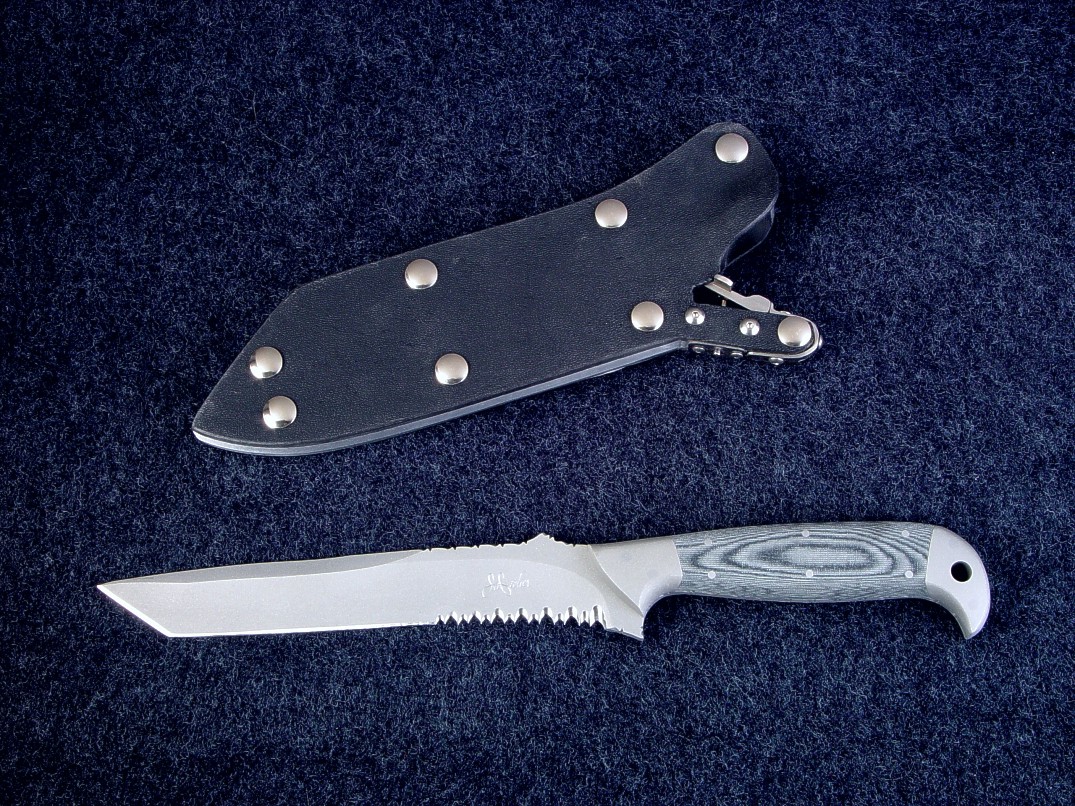 More
More about this PJLT
Since making the PJLT is a custom affair, and since it is my most popular
knife, you'll see many variations of the PJLT on my site and some are featured below.
Some are artistic adaptations, some are derivatives of the original PJLT design,
adapted for Pararescue and professional use. This is a versatile knife
design, and I look forward to experiencing the evolution of the PJLT in my
future years. Please check back as I continually update the website.
Thanks most for supporting our military, rescue, and law enforcement
professionals who make it possible for us to love the life we live in
the United States of America!
Page Topics
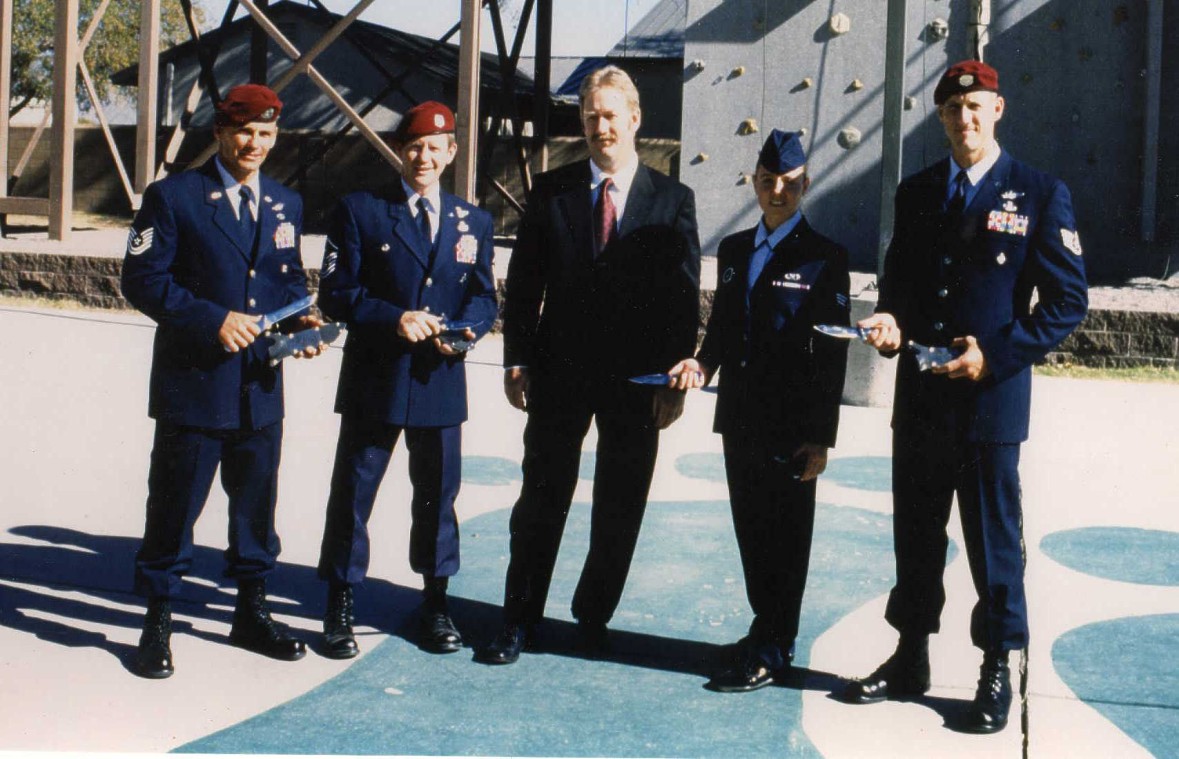
Jay Fisher and Pararescuemen, SERE Professionals, c. 1996
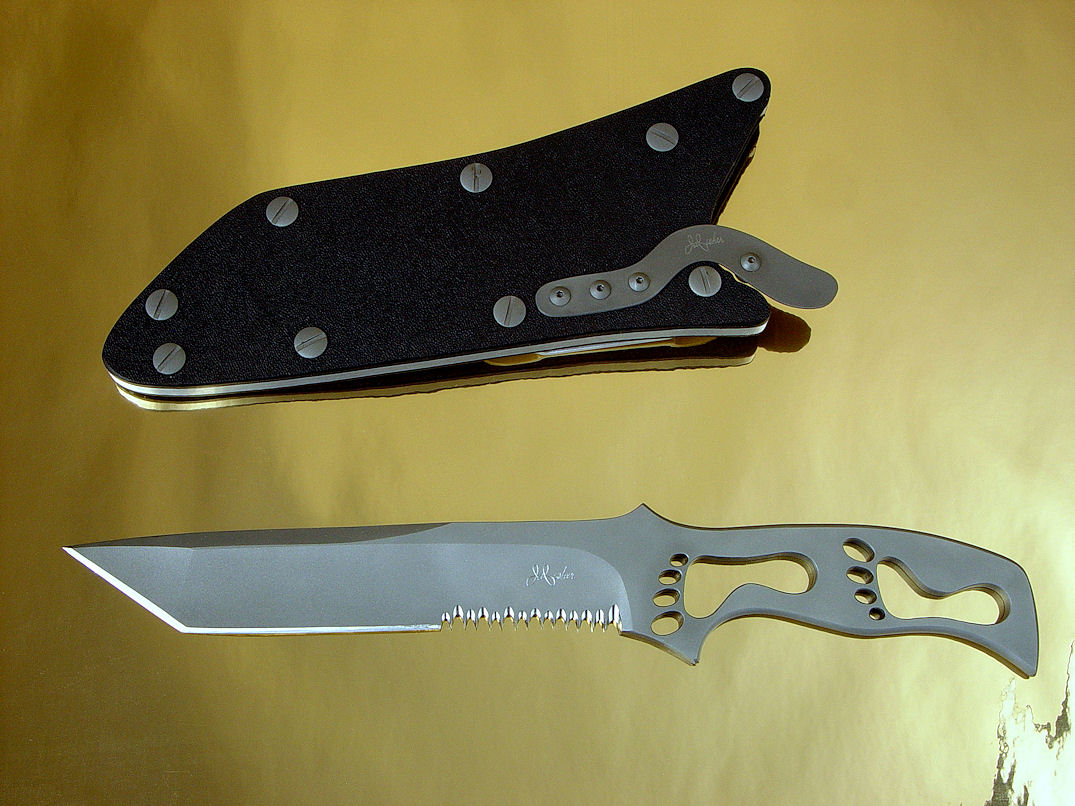 More
More about this PJSK Viper
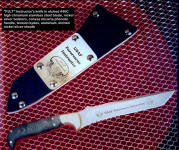
PJLT Instructor's
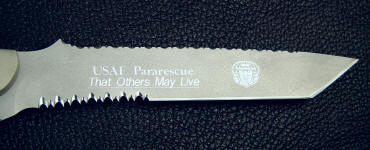
Engraved PJLT Dedication
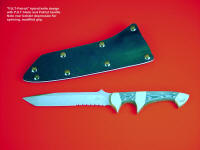
PJLT/Patriot
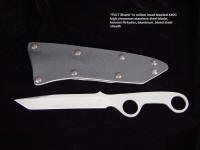
PJLT Shank
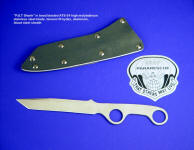
PJLT Shank
